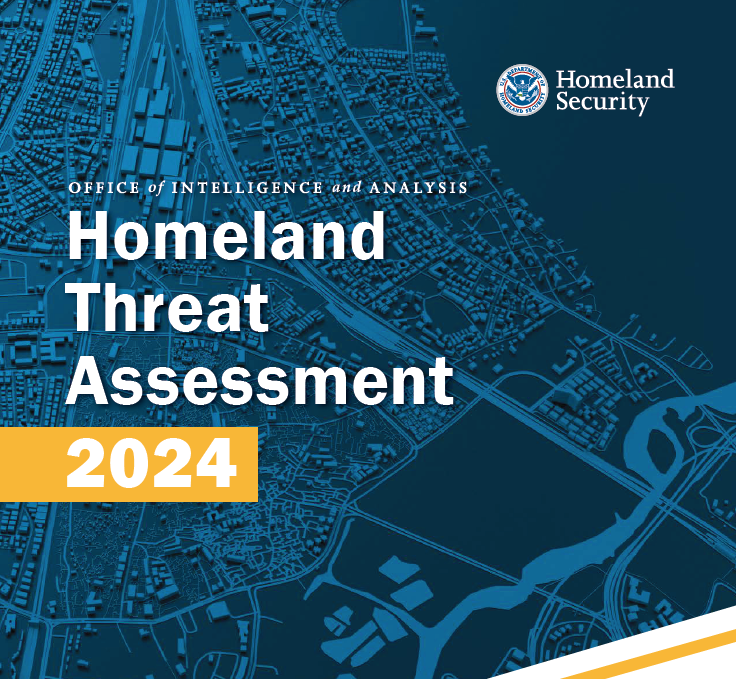FBI Director Warns ‘Dangerous Individuals’ Are Crossing the Border
FBI Director Christopher Wray issued an ominous warning during a hearing last week before the Senate Select Committee on Intelligence (SSCI) about a “wide array of very dangerous threats that emanate from” the Southwest border. Don’t feel bad if you missed it, because it didn’t get much coverage, but the interesting thing is Wray likely knew about — and may have been specifically referencing — the self-proclaimed Hezbollah member caught crossing that border two days earlier in El Paso, Texas.
“Going to Try to Make a Bomb”. The alien in question is Basel Bassel Ebbadi, a 22-year-old Lebanese national, and the incident was initially revealed by Jennie Taer at the New York Post in a March 17 article headlined “Illegal migrant from Lebanon caught at border admitted he’s a Hezbollah terrorist hoping ‘to make a bomb’ — and was headed for NY”.
Ebbadi was apprehended on March 9 near El Paso, and according to Taer, he was initially forthcoming about his terrorist plans in this country: “While in custody, he was asked what he was doing in the US, to which he replied, ‘I’m going to try to make a bomb’, according to a Border Patrol document.”
Thereafter, however, he changed his story, telling ICE that he came illegally because he was “trying to flee Lebanon and Hamas because he ‘didn’t want to kill people’ and said ‘once you’re in, you can never get out’”.
Hamas, Hezbollah, the Houthis — and Iran’s “Axis of Resistance”. The “Counter Terrorism Guide” published by the Director of National Intelligence (DNI) explains that the 20,000 to 25,000 members of Hamas — a terror group first designated as a foreign terrorist organization (FTO) by the State Department in October 1997 — operates primarily in Gaza, but that it also has a presence in the West Bank and in refugee camps in Lebanon.
The group, of course, also planned and carried out the October 7 attacks in Israel, when 1,000 Hamas fighters poured through 30 breaches in the Israeli border wall with Gaza, killing 1,200 people, raping countless others, and taking “roughly 250” hostage.
Meanwhile, DNI reports that “Lebanese Hizballah”, which was also designated as an FTO in October 1997: “Operates throughout Lebanon with relative impunity; has also worked with Iranian officials to provide training and other military support to Shia militants in Iraq, Syria, and Yemen; has conducted lethal attacks globally.”
Both Hezbollah/Hizbollah and Hamas are “aligned” with the Islamic Republic of Iran, sworn enemy of the United States and general disrupter of the international order in the Middle East. Consequently, there are ties between the two groups as well as with the Houthis in Yemen, members of which, AP explains, are “sometimes seen as the loose cannons of the alliance”.
The Biden administration “delisted” the Houthis as an FTO less than a month after the inauguration, as the White House withdrew support for Saudi-led efforts to intervene in the civil war that has been raging in Yemen since 2015.
The State Department was forced to redesignate the group as an FTO in January 2024, however, explaining:
Since November, the Houthis have launched unprecedented attacks against international maritime vessels in the Red Sea and Gulf of Aden, as well as military forces positioned in the area to defend the safety and security of commercial shipping. These attacks against international shipping have endangered mariners, disrupted the free flow of commerce, and interfered with navigational rights and freedoms.
In case you aren’t up on your Middle East geography, Yemen sits at the southeastern part of the Arabian peninsula, including at a Houthi-controlled choke point called the Bab al-Mandab Strait where the Red Sea flows into the Gulf of Aden and enters into the Indian Ocean. Not only oil tankers use that passage, but so does every ship that passes through the Suez Canal, from and to the Mediterranean.
The strategic importance of that strait is why the British occupied Aden between 1839 and 1967, and why the U.S. African Command and its Combined Joint Task Force – Horn of Africa is headquartered on the other side of the strait in the African nation of Djibouti.
The Houthi attacks on shipping in the Red Sea and Gulf threaten the 10 percent of global commerce that goes through the strait. Consequently, as Time explains: “If the Houthi blockade continues, the costs to consumers and the impact on local states will be considerable.”
Not surprisingly, the Houthis are engaging in those attacks because they are part of Iran’s “axis of resistance”, and are trying to aid Hamas by undermining the Israeli war effort in Gaza.
The fear in Israel and elsewhere is that Hezbollah would launch its own attacks on Israel to help Hamas out as well, and in fact it did fire rockets from Lebanon into Israel on October 8, starting a low-level back and forth that has been ongoing ever since.
Ominously, Esmail Qaani, the head of Iran’s Quds Force has reportedly met with Hezbollah chief Sayyed Hassan Nasrallah three times since the Hamas attacks of October 7.
“A Heightened Threat Level from a Terrorism Perspective”. Which brings me back to Wray’s comments before SSCI on March 11, when he explained:
Even before October 7, I would have told this committee that we were at a heightened threat level from a terrorism perspective — in the sense that it’s the first time I’ve seen in a long, long time … . The threats from homegrown violent extremists that is jihadist-inspired, extremists, domestic violent extremists, foreign terrorist organizations, and state-sponsored terrorist organizations all being elevated at one time since October 7, though, that threat has gone to a whole other level. And so, this is a time I think for much greater vigilance, maybe been called upon us.
Notably, in response to questioning from SSCI Vice Chair Sen. Marco Rubio (R-Fla.) about criminals entering illegally across the Southwest border and being released into the country, Wray stated: “We have had dangerous individuals enter the United States of a variety of sorts. … From an FBI perspective, we are seeing a wide array of dangerous threats that emanate from the border”.
Rubio then asked Wray whether any of the smugglers bringing illegal migrants to the United States had ties to “ISIS or other terrorist organizations”.
Wray responded:
So, I want to be a little bit careful about how far I can go in open session, but there is a particular network that has, where some of the overseas facilitators of the smuggling network have ISIS ties that we’re very concerned about and that we’ve been spending enormous amount of effort with our partners that we’re investigating.
ISIS and the Iranian-led axis of resistance are on very different pages ideologically and politically (an offshoot of ISIS took responsibility for bombings at a memorial service for former Quds Force commander Qassem Soleimani in January that killed 100), but Rubio only focused on ISIS and Wray was pretty tight-lipped generally, as the excerpt above reveals.
“Complex Border and Immigration Security Challenges”. In its “Homeland Threat Assessment 2024”, DHS’s Office of Intelligence and Analysis (OIA) warned (emphases added):
The complex border and immigration security challenges we have faced over the last year are likely to continue. Although encounters with migrants have declined from record highs in December, migrants seeking entry to the United States are still arriving at a rate that is on pace to nearly match 2022 total encounters. As part of this increase, we have encountered growing numbers of individuals in the Terrorist Screening Data Set (TSDS), also known as the “watchlist.”
. . .
Record numbers of migrants traveling from a growing number of countries have been encountered at our borders this fiscal year. . . . Terrorists and criminal actors may exploit the elevated flow and increasingly complex security environment to enter the United States.
Individuals with potential terrorism connections continue to attempt to enter the Homeland. As of July, approximately 160 non-US persons in the TSDS attempted to enter the United States via the southern border this year, most of whom were encountered attempting to illegally enter between ports of entry. This represents an increase from the approximately 100 encounters in all of FY 2022.
The Islamic Republic and its terror proxies received their own special notice in that report: “Among state actors, we expect Iran to remain the primary sponsor of terrorism and continue its efforts to advance plots against individuals in the United States”.
Why would Iran and its terror allies want to attack the United States? As Director Wray noted, even before the October 7 attacks, various terrorist groups posed a threat (Soleimani was killed in a U.S. airstrike and Iran vowed revenge), but in the minds of many, American support for Israeli in the wake of October 7 now especially makes our homeland a legitimate target.
That includes not just FTOs, but also 80 musical acts that were scheduled to appear at the March South by Southwest (SXSW) concert series in Austin, Texas. They are now pulling out of SXSW because the U.S. military and a number of military contractors are among those sponsoring the event — groups they blame for supporting Israel’s military actions in Gaza.
As the former head of the INS’s National Security Law Division, I can tell you that it’s rare for a migrant like Ebbadi to be quite so forthcoming about his terrorist intentions. Even if the administration is willing to ignore the claims of a Lebanese migrant, it should pay heed to warnings from the FBI director and DHS’s intelligence division about the terrorism vulnerabilities created by an insecure border.






